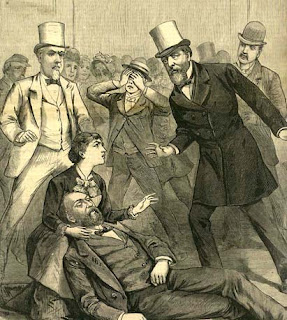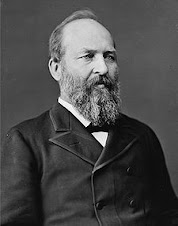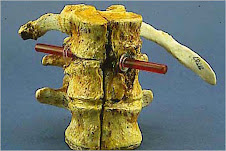If you were to ask most Americans who killed James A. Garfield, the most common response you’d probably receive would be, “Who?” It’s hard to find fault with anyone unfamiliar with Mr. Garfield, the twentieth president of the United States. He was a dark horse candidate to begin with, having been nominated by the Republican Party in 1880 only after a bitter intraparty battle at the Republican convention in Chicago had ended in impasse.

The two rival factions within the party, the Stalwarts and the Half-Breeds, remained deadlocked through thirty-three different ballots, with the Stalwarts supporting a third term for Ulysses S. Grant and the Half-Breeds divided between James G. Blaine and John Sherman. On the thirty-fourth ballot, members of the delegation from Wisconsin “unexpectedly gave sixteen votes to Garfield.”[1] On the next ballot, Indiana would follow suit, prompting a flood of Blaine and Sherman supporters to switch “to Garfield and the dark horse candidate had a majority and the nomination.”[2] In an attempt to appease the Stalwarts, Garfield chose Chester A. Arthur, a confidant of Stalwart leader Roscoe Conkling, to be his vice-president.[3] In one of history’s odd coincidences, Garfield had, while at college in 1854, held a teaching position in Pownal, Vermont that Arthur had held the year prior.[4]
Garfield’s presidency would last only seven months, further condemning him to presidential obscurity. In a C-SPAN survey conducted in 2009, Garfield ranked twenty-ninth out of the forty-one presidents included, while an MSNBC survey, also from 2009, ranked him twenty-eighth, up from twenty-ninth in 2000. Some polls exclude Garfield altogether due to the brevity of his tenure. Far less popular than presidents such as Lincoln and Washington, and lacking the notoriety of Nixon or Andrew Johnson, Garfield has been relegated to an undesirable post among those presidents easiest to forget.
Unfortunately for Garfield, his most memorable achievement was being assassinated by Charles Guiteau. Posterity has seen fit to label Guiteau a disappointed office-seeker, when in fact he was quite mad. Guiteau had delusions of a prestigious appointment within Garfield’s cabinet, but had no qualifications whatsoever, having been little more than a wanderer and petty criminal before shooting Garfield. While on trial, Guiteau would assert that he had not been ultimately responsible for Garfield’s death. According to Guiteau, “General Garfield died from malpractice.”[5] It was Guiteau’s belief that the doctors who mistreated Garfield “ought to bear the odium of his death, and not his assailant.”[6] Guiteau was very much “a lunatic with few sane thoughts,”[7] but he was not far off the mark regarding the treatment Garfield received at the hands of his doctors.
The goal of this blog is to elucidate the events that led to the death of James A. Garfield so that readers can make their own assessment as to who “ought to bear the odium of his death.”[8] While it is obvious that Guiteau was ultimately responsible, as he fired the bullet that precipitated the calamitous chain of events, there were medical professionals that at the time asserted Garfield’s wound was not necessarily fatal. Should those charged with the president’s care share responsibility for his death with Charles Guiteau? The pernicious case of James A. Garfield deserves a second look.
The Assault on Garfield
On July 2, 1881, a Saturday, Secretary of State James G. Blaine escorted President James A. Garfield to the Baltimore and Potomac train depot in Washington, D.C., from which the president would depart for New York City. Awaiting them at the depot were other members of Garfield’s cabinet, including Secretary of the Navy William Hunt, Postmaster General Thomas James, Secretary of War Robert Todd Lincoln, and Secretary of the Treasury William Windom, who along with their wives would travel with the president on his two-week vacation through New England.[9] Garfield’s wife, Lucretia, who had been convalescing in New Jersey after a bout with malaria and possibly spinal meningitis, was scheduled to join them in New York City.



Meanwhile, “a distressed Blaine, crying out, ‘O my poor President!’ tried to shield Garfield from the growing crowd.”[16]

A health officer for the District of Columbia soon arrived and examined the fallen president. Upon being told his wound was not serious, Garfield “shook his head and said, ‘Doctor, I am a dead man.’”[17] Garfield would not be that lucky. Not yet. For Blaine’s “poor President,” a great and terrible ordeal had just begun.
The Aftermath

When Charles Guiteau fired two rounds from his British Bulldog, he set into motion a calamitous chain of events that would rob James Garfield of his life and the American people of their president. At the time, the attack on Garfield was, obviously, a massive event. “A Great Nation in Grief,” read the New York Times, reporting that the assassination attempt had left “the nation horrified and the whole civilized world shocked.”[18] Newspapers from Philadelphia to San Francisco and from New Orleans to Duluth bore headlines relating to the president’s condition. “President Garfield Shot and Dangerously Wounded,” [19] proclaimed the Duluth Daily Tribune. “Garfield Hovers between Life and Death – Bulletins of His Condition,”[20] offered the Kansas City Star.

The infamous comments made by Guiteau after his arrest, “I am a Stalwart and Arthur will be president,”[21] also drew its share of headlines, prompting some to suggest that Chester Arthur “or other Stalwarts had hired Guiteau to shoot the president.”[22] In this regard the New York Times offered the following opinion:
Whether the assassin had accomplices or not, whether his design was known to those who were to profit by his crime or not, the fact stands out in startling prominence that the murderer was by his own confession, inspired with the same motives that have actuated the third term conspirators from the very beginning, and that he fired the fatal shot for the distinct purpose of accomplishing their plot, by the succession of Mr. Arthur to the Presidency.[23]
The uproar over the circumstances of Arthur’s ascension to the presidency would be short-lived, as was “the tremendous outpouring of grief and adulation occasioned by Garfield’s death.”[24] A decade later, “the Stalwarts and Half-Breeds had disappeared from the political scene and Garfield’s brief presidency was forgotten.”[25]
The Pernicious Case of James A. Garfield
Minutes after the shooting, Smith Townshend, the District of Columbia health officer, examined Garfield’s wound with his bare, unwashed hands. Townshend was “the first of what would be numerous individuals to place their unwashed fingers and unclean instruments directly into the president’s wound.”[26] Townshend could not find the bullet, but it was his belief that the wound was not fatal. The president, Townshend believed, would recover. Ironically, Townshend was correct in his diagnosis of the wound, which by itself would not have killed Garfield. It was the treatment he received at the hands of his doctors that would ultimately bring about his death.
Garfield was soon moved to a more private room on the depot’s second floor. Secretary of War Lincoln, who sixteen years earlier “had watched his own father die from an assassin’s bullet,”[27] sent for Doctor Willard Bliss, a surgeon who had gained renown as a gunshot wound expert during the Civil War and “as surgeon in chief to the U.S. Army’s Armory Hospital in Washington.”[28] Bliss, who’s given first name was actually Doctor,[29] examined the president’s wound with unwashed hands. Unsatisfied with the digital examination:
Bliss took a Nelaton probe, a slender rod of flexible metal with a blunt bulbous tip, and pushed it into the wound’s opening hoping to make contact with the bullet.
It is very likely that the instrument had not been cleaned from its previous use, and no attempts were made to wash it at the depot.[30]
Bliss would try again with a different device, which was also unsterilized. Afterwards, “temporary but unclean dressings were applied to the wound.”[31] This trend of unsanitary medical practices, appalling when viewed from today’s vantage point, would continue until, and contribute directly to, Garfield’s death.

Doctor Bliss would take complete control of the president’s care; according to Bliss, this was done at the behest of Garfield and his wife. Regardless of how he came to be in charge, Bliss’s involvement would have disastrous consequences for Garfield.
American medicine was in the middle of a revolution in 1881, as “America’s healers were emerging from the restraints of ignorance and superstition to become world leaders in medical education and research.”[32] In the mid-1860’s, Jacob Lister discovered that “to destroy germs on a wound or to prevent their entrance into the injury will lessen the chance of infection.”[33] Lister’s system of antisepsis was one of the most fundamental breakthroughs in medicine and very well might have changed Garfield’s fate. Unfortunately for Garfield, Bliss was on the wrong side of that medical revolution, entrenched in antiquated medical dogma and highly resistant to change. Bliss, like many American physicians in 1881, was “not ready to embrace Lister’s breakthrough concept.”[34]
Bliss was hardly alone in his ignorance; many older doctors during the period had learned their craft on the job and were limited in their efficacy due to a “poor background in the basic sciences.”[35] Bliss’s lack of proper medical education led him to repeatedly contaminate Garfield’s wound and subsequently misdiagnose symptom after symptom. Bliss claimed the bullet had entered Garfield’s liver, when it would later be found “lodged deep in the tissues of the president’s left back.”[36] While the bullet had splintered two ribs and fractured the thoracic and lumbar vertebrae,[37] it did so without injuring the spinal cord and should not have been lethal. Bliss believed the pus discharged from the wound to be a sign of healing, when it was in fact caused by infection. Bliss also misdiagnosed Garfield’s febrile condition, another sign of infection, as malaria.
Bliss and his team were ignorant of “the relationship between germs, diseases, and death;”[38] James Garfield would suffer a slow and terrible demise because of it. Pus pockets began forming throughout the president’s body. A carbuncle formed in Garfield’s right parotid gland, “causing excruciating pain, swelling of his eye and cheek, and paralysis of the face.”[39] When Garfield could no longer keep down solid foods, Bliss began rectal feedings.[40] The ignominious process would do Garfield little good; the president’s weight plummeted from 225 to 130 pounds. “Garfield was literally starving to death.”[41]
In September, a frustrated Garfield demanded to leave Washington for a seaside cottage in Elberon on the New Jersey Shore. The president hoped the sea air would ease his suffering, but “his chills, fever, and vomiting continued unabated, and the beginnings of a worrisome cough, indicative of spreading pneumonia, appeared.”[42] On the night of Monday, September 19, thirteen days after his arrival in Elberon, Garfield cried out in response to a “terrible pain.”[43] He soon lapsed into a coma. Bliss leaned over to put his ear to Garfield’s chest--Bliss disapproved of the recently developed stethoscope[44]--but heard little. Minutes later, at 10:35 PM, Garfield’s respirations ceased.[45] His terrible ordeal was over.
An autopsy was performed, revealing that the president’s wound had not necessarily been fatal. One of Bliss’s contemporaries, former Surgeon General and co-founder of the American Neurological Association William A. Hammond, suggested as much in an article appearing in the North American Review a few months after Garfield’s death:
It appears to me, therefore, and I think the great majority of civil and military surgeons will agree with me, that, while the President’s wound was a serious one, there was not a single feature or combination of features about it which rendered death inevitable.[46]
In regards to the care Garfield received, Hammond’s assertions were just as damning:
It is asserted that during the first forty-eight hours the surgical practice was not in accordance with well-defined and acknowledged surgical precepts, and that hence the President did not have all the advantages of treatment which modern surgery is capable of affording.[47]
The ultimate causes of Garfield’s death were infection and starvation,[48] both of which resulted from the medical incompetence of Bliss and his staff. Bliss, however, blamed Garfield’s death on a broken backbone. He made no mention of “antisepsis, germs, pus, or their relationships.”[49] Bliss had misled the public regarding the president’s condition from the start, and had no intention of altering his approach upon Garfield’s death. As the president’s ordeal had dragged on, word of dissention among those charged with Garfield’s care was leaked to the press, as was the possibility of deliberate deception regarding the president’s condition. Some newspapers went so far as to stop printing Bliss’s daily medical bulletins, “believing they misled the public.”[50] The New York Daily Tribune lashed out at Bliss’s repeated equivocations:
It is the duty of a physician to care for his own reputation at the same time that he guards the life of his patient, and, at this stage of the case, with the whole country aware of the gravity of the crisis, no physician, even if he knew no higher moral law than a selfish desire to protect his professional fame, should hold out hope when he knows the event will prove him a false prophet.[51]
“An embittered and lonely man,”[52] Bliss would die of heart failure eight years later. His supporters claimed it was caused by “the pressures of treating Garfield.”[53] Joseph Woodward, Bliss’s second-in-command, became depressed and committed suicide in 1884.[54]
President Garfield’s death and the controversy surrounding it would come to separate the old and new in American Medicine.[55] It would spark “an increasing number of positive articles concerning antisepsis,” bringing “about the acceptance of Listerism by the late 1880’s.”[56] “The absence of trained and experienced nurses”[57] from Garfield’s care would also anger Americans. A forum would be held at the Chicago World’s Fair in 1893 “to develop national standards for the organization and administration of America’s nursing schools,”[58] resulting in the rapid expansion of nursing programs. Another result of the Garfield tragedy was a trend toward specialization in medicine, “as physicians realized the error of not having more specialty-style care available.”[59]
Video Courtesy of www.jamesgarfield.org
Bibliography:
“A Great Nation in Grief,” New York Times, Jul 3, 1881, 1857-
Current file, http://www.proquest.com (accessed November
19, 2009).
Ackerman, Kenneth D. Dark Horse: The Surprise Election and
Political Murder of President James A. Garfield (New York: Carroll & Graf, 2003).
DeGregorio, William A. The Complete Book of U.S. Presidents: From
George Washington to George W. Bush, 6th ed. (New York: Gramercy, 2005).
“Garfield Hovers between Life and Death – Bulletins of His
Condition,” Kansas City Star, 07-02-1881, Volume: 1, Issue: 247, Page: [1], http://infoweb.newsbank.com (accessed November 19, 2009).
Hammond, William A., Ashhurst, Jr., John, Sims, J. Marion,
Hodgen, John T. "The Surgical Treatment of President Garfield,” The North American Review, Vol. 133, No. 301 (Dec, 1881), pp. 578-610, http://www.jstor.org/stable/25101018 (accessed November 20, 2009).
“Opinions of the Press,” New York Times, July 3, 1881, 1857-
Current file, p. 5, http://www.proquest.com (accessed November 18, 2009).
“President Garfield Shot and Dangerously Wounded!” The Duluth
Daily Tribune, 07-02-1881, Volume: I, Issue: 42, Page: [1], http://infoweb.newsbank.com (accessed November 19, 2009).
Rosenberg, Charles E. The Trial of the Assassin Guiteau:
Psychiatry and Law in the Gilded Age (Chicago: The University of Chicago Press, 1968).
Rutkow, Ira. James A. Garfield (New York: Times Books, 2006).
Schaffer, Amanda. “A President Felled by an Assassin and 1880’s
Medical Care,” New York Times, July 25, 2006, http://www.nytimes.com (accessed November 19, 2009).
Who Named it?, "William Alexander Hammond,"
http://www.whonamedit.com/doctor.cfm/542.html (accessed November 20, 2009).
[1] Ira Rutkow, James A. Garfield (New York: Times Books, 2006), 55.
[2] Ibid.
[3] Ibid., 56.
[4] Ibid., 8.
[5] Ibid., 130.
[6] Ibid.
[7] Ibid., 131
[8] Ibid.
[9] Ibid., 82.
[10] Ibid.
[11] Charles E. Rosenberg, The Trial of the Assassin Guiteau: Psychiatry and Law in the Gilded Age (Chicago: The University of Chicago Press, 1968), 40.
[12] Ibid.
[13] Rutkow, Garfield, 83.
[14] Kenneth D. Ackerman, Dark Horse: The Surprise Election and Political Murder of President James A. Garfield (New York: Carroll & Graf, 2003), 378.
[15] “A Great Nation in Grief,” New York Times, Jul 3, 1881, 1857- Current file, http://www.proquest.com (accessed November 19, 2009).
[16] Rutkow, Garfield, 84.
[17] Ibid., 2-3.
[18] “A Great Nation in Grief,” New York Times
[19] “President Garfield Shot and Dangerously Wounded!” The Duluth Daily Tribune, 07-02-1881, Volume: I, Issue: 42, Page: [1], http://infoweb.newsbank.com (accessed November 19, 2009).
[20] “Garfield Hovers bBetween Life and Death – Bulletins of His Condition,” Kansas City Star, 07-02-1881, Volume: 1, Issue: 247, Page: [1], http://infoweb.newsbank.com (accessed November 19, 2009).
[21] “A Great Nation in Grief,” New York Times.
[22] William A. DeGregorio, The Complete Book of U.S. Presidents: From George Washington to George W. Bush, 6th ed. (New York: Gramercy, 2005), 311.
[23] “Opinions of the Press,” New York Times, July 3, 1881, 1857-Current file, p. 5, http://www.proquest.com (accessed November 18, 2009).
[24] Rutkow, Garfield, 135.
[25] Ibid., 136.
[26] Ibid., 84-85.
[27] Ackerman, Dark Horse, 380.
[28] Rutkow, Garfield, 85.
[29] Ibid., 86.
[30] Ibid.
[31] Ibid., 87.
[32] Ibid., 97.
[33] Ibid., 105.
[34] Ibid., 105.
[35] Ibid., 110.
[36] Ibid., 128.
[37] Ibid., 139.
[38] Ibid., 128.
[39] Ibid., 119.
[40] Ibid.
[41] Ibid.
[42] Ibid., 125.
[43] Ackerman, Dark Horse, 426.
[44] Rutkow, Garfield, 127.
[45] Ibid.
[46] William A. Hammond, John Ashhurst, Jr., J. Marion Sims, John T. Hodgen, "The Surgical Treatment of President Garfield,” The North American Review, Vol. 133, No. 301 (Dec, 1881), pp. 578-610, http://www.jstor.org/stable/25101018 (accessed November 20, 2009).
[47] Ibid.
[48] Amanda Schaffer, “A President Felled by an Assassin and 1880’s Medical Care,” New York Times, July 25, 2006, http://www.nytimes.com (accessed November 19, 2009).
[49] Rutkow, Garfield, 128.
[50] Ibid., 123.
[51] Ibid.
[52] Ibid., 134.
[53] Ibid.
[54] Ibid.
[55] Ibid., 132.
[56] Ibid.
[57] Ibid., 133.
[58] Ibid., 134.
[59] Ibid.


